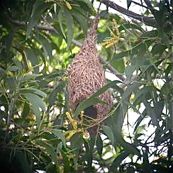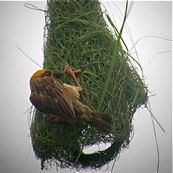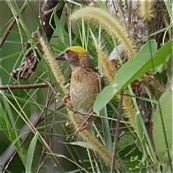Seow Boon Eu of Penang, Malaysia was observing Baya Weavers (Ploceus philippinus) constructing their elaborate nests attached to the acacia tree (Acacia auriculiformis) (below left).
Acacia trees originate from tropical Australia and New Guinea, introduced as roadside trees. These trees find conditions so suitable that they spread far and wide, growing in a wide range of soil types, including degraded soils. The tree produces curled pods that split on ripening to release black seeds dangling on curled orange stalks (below).
Birds love the orange stalks, gobbling them together with the seeds. The stalks may be digested but the seeds definitely pass out some distance away. In this way birds help spread the acacia far and wide. In many parts of Southeast Asia, this tree has become naturalised.
It is not known whether these weavers eat acacia seeds. But they definitely take grass seeds, especially those of feathery pennisetum (Pennisetum polystachion) and elephant grass or napier grass (P. purpureum) (above right). In addition, the leaves of these grasses provide nesting materials for their nests (above centre).
This post is courtesy of Seow Boon Eu of Bonyou.
Image of acacia fruits by YC, all others by Boon Eu.












